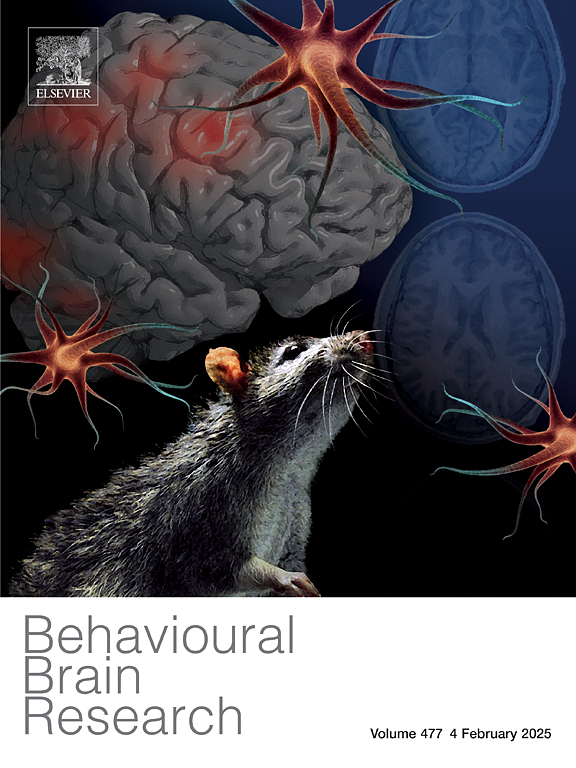Effects of astrocytes in the dorsal hippocampus on anxiety-like and depressive-like behaviors in hemiparkinsonian rats
IF 2.6
3区 心理学
Q2 BEHAVIORAL SCIENCES
引用次数: 0
Abstract
Anxiety and depression are the most common neuropsychiatric manifestations of Parkinson’s disease (PD) patients. Growing evidence have shown that the dorsal hippocampus (dHIPP) and astrocytes (AS) may be involved in regulating depression and anxiety, but the role and mechanism are still unclear, especially in PD-related depression and anxiety. Unilateral 6-hydroxydopamine lesions of the substantia nigra pars compacta (SNc) were used to establish the rat model of PD. Behavioral tests and measurement of monoamine levels in the depression and anxiety related brain regions were performed to investigate the effects of chemogenetic activation or inhibition of dHIPP AS on PD-related anxiety and depression. The present results showed that unilateral lesions of the SNc induced anxiety-like and depressive-like behaviors, decreased dopamine (DA) levels in some related brain regions, but did not change the density of glial fibrillary acidic protein-positive AS in the CA1, CA3 and dentate gyrus in rats. Chemogenetic inhibition of dHIPP AS significantly improved anxiety-like and depressive-like behaviors only in the lesioned rats, while chemogenetic activation of dHIPP AS had no effects on anxiety-like and depressive-like behaviors in sham-operated and the lesioned rats. Chemogenetic activation of dHIPP AS only decreased DA level in the ventral hippocampus (vHIPP) in sham-operated rats, while inhibition of dHIPP AS increased 5-hydroxytryptamine (5-HT) levels in the medial prefrontal cortex (mPFC) and vHIPP in sham-operated rats and also in the amygdala, mPFC, lateral habenula, dHIPP and vHIPP in the lesioned rats. These results indicate that chemogenetic inhibition of dHIPP AS improves the anxiety-like and depressive-like behaviors in the lesioned rats through the changes in monoamine in some brain regions.
海马背侧星形胶质细胞对半帕金森大鼠焦虑样和抑郁样行为的影响。
焦虑和抑郁是帕金森病(PD)患者最常见的神经精神表现。越来越多的证据表明,海马背侧(dHIPP)和星形胶质细胞(AS)可能参与调节抑郁和焦虑,但其作用和机制尚不清楚,特别是在pd相关的抑郁和焦虑中。采用黑质致密部(SNc)单侧6-羟多巴胺损伤建立PD大鼠模型。通过行为测试和抑郁和焦虑相关脑区的单胺水平测量,研究化学发生激活或抑制dHIPP AS对pd相关焦虑和抑郁的影响。本研究结果表明,单侧SNc损伤引起大鼠焦虑样和抑郁样行为,部分相关脑区多巴胺(DA)水平降低,但未改变大鼠CA1、CA3和齿状回胶质原纤维酸性蛋白阳性AS的密度。化学发生抑制dHIPP AS仅在损伤大鼠中显著改善焦虑样和抑郁样行为,而化学发生激活dHIPP AS对假手术大鼠和损伤大鼠的焦虑样和抑郁样行为无影响。化学发生激活dHIPP AS仅降低假手术大鼠腹侧海马(vHIPP) DA水平,而抑制dHIPP AS增加假手术大鼠内侧前额叶皮质(mPFC)和vHIPP以及受损大鼠杏仁核、mPFC、外侧链、dHIPP和vHIPP的5-羟色胺(5-HT)水平。这些结果表明,化学发生抑制dHIPP AS通过改变部分脑区单胺来改善损伤大鼠的焦虑样和抑郁样行为。
本文章由计算机程序翻译,如有差异,请以英文原文为准。
求助全文
约1分钟内获得全文
求助全文
来源期刊

Behavioural Brain Research
医学-行为科学
CiteScore
5.60
自引率
0.00%
发文量
383
审稿时长
61 days
期刊介绍:
Behavioural Brain Research is an international, interdisciplinary journal dedicated to the publication of articles in the field of behavioural neuroscience, broadly defined. Contributions from the entire range of disciplines that comprise the neurosciences, behavioural sciences or cognitive sciences are appropriate, as long as the goal is to delineate the neural mechanisms underlying behaviour. Thus, studies may range from neurophysiological, neuroanatomical, neurochemical or neuropharmacological analysis of brain-behaviour relations, including the use of molecular genetic or behavioural genetic approaches, to studies that involve the use of brain imaging techniques, to neuroethological studies. Reports of original research, of major methodological advances, or of novel conceptual approaches are all encouraged. The journal will also consider critical reviews on selected topics.
 求助内容:
求助内容: 应助结果提醒方式:
应助结果提醒方式:


